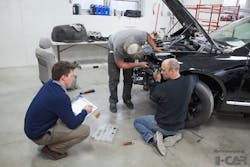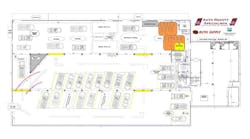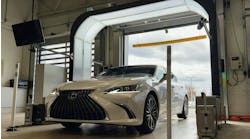The goal of vehicle blueprinting is not complicated -- to write a “perfect estimate” to include all parts and procedures needed to repair the vehicle. Instead of writing a traditional estimate to include only what is visible, blueprinting requires a complete disassembly of all repairs, large or small, before the vehicle is placed into production. The idea is for the vehicle to proceed smoothly through the repair process with minimum delays, but even shop owners and managers who use the blueprinting process may not be using it to its potential.
“When I teach classes around the country, and I ask the question, ‘How many of you blueprint?' everybody raises their hand,” said Mark Bono, estimatics and technical training manager for Bill Brown Ford Collision Center in Livonia, Michigan. “But as you go through the class and you talk to people, you get indications they’re not really doing it to the full extent they should be.”
Bono is also an I-CAR instructor, and as president of Collision Industry Training, Consulting, and Organizational Development (CITCOD), he also trains around the country, including for PPG’s MVP program. Of those who claim to be blueprinting, he figures only about 10 percent of them perform it to the level they should, which requires specialization and dedication to the process.
A true blueprinting process, he said, typically requires two people: one to disassemble and identify damage and an estimator who writes the blueprint and looks up OEM repair procedures — in this example to repair a bent frame rail. Can the rail be sectioned? Or must it be replaced? Then the parts department or supplier is consulted to ensure the part is available.
“It’s difficult, I think, for a lot of shops to invest the money involved with a blueprint department, so they try to create a hybrid system,” Bono said. “I’ve worked for some shops that have the idea of, ‘We’re going to take the porter and make them into a disassembler.’ Well, that doesn’t work, because I need somebody with knowledge.”
The process requires someone accustomed to damage analysis, he said, who can identify when the seam sealer is stretched and infer the frame rail may likely be bent.
So why is it not efficient for the assembling technician to also be the one to assist with blueprinting? Bono said what he often finds is the blueprint stops short of completion.
“The technician takes everything apart so that he can discover all the damage, but he doesn’t take apart the blend panel on the door. And no one in management steps up and says, ‘Look, I’m not going to write your supplement until everything is apart.’”
Skipping the disassembly of a blend panel at the time of the blueprint means clips may break, or one-time-use parts may not get caught until it’s time to assemble.
A technician who is called away occasionally from his or her work in the body department to work in the blueprinting department as a disassembler may not recognize how efficient a thorough blueprint can be in saving time and reducing supplements and instead be concerned with the works-in-progress awaiting their repair. Thus, it takes a culture change for such an arrangement to be effective, Bono said.
“It has to come from the ownership down to the people on the bottom: We don’t move forward to the next step until the first step is complete. Disassembly is one of those areas that I think most frequently is lacking. Most of them don’t understand that I can save time and money if I find all the damage up front, and then when I get all of my parts, I can get the car done faster.”
Slow down to go faster
Taking the time to methodically find all needed parts up front can take an adjustment, said Scott VanHulle, manager of Repairability Technical Support and OEM technical relations for I-CAR, which offers multiple courses on blueprinting, such as “Blueprinting for the Estimator” and “Blueprinting for the Non-structural Technician.”
“It’s very counter-intuitive, especially for shop guys who are used to running around putting out fires and just sprinting all the time trying to catch up,” he said. “But if you take your time in the beginning and make sure you find everything, that’s what’s going to save you time at the end of the repair.”
Years ago, he said, I-CAR conducted a study on the blueprinting process.
“And one of the things that helped cycle time the most was our trim and hardware course. Knowing how to take a car apart so that you don’t break that clip is critical.”
It’s often that one missed little part, especially a non-standard clip, that can extend cycle time, VanHulle pointed out.
Blueprinting does not end at disassembly, said Bud Center, I-CAR director of technical products and curriculum, and it should include understanding what tools and equipment are needed for the repair, such as a jig system that may need to be rented for structural repairs.
“And if you have to sublet glass or whatever it might be, coordinate with your sublet vendors so that those operations are completed at the appropriate time during the repair process,” Center said. “Confirm parts availability so that when the car hits the production floor, it doesn’t have to wait for parts.”
Erin Solis, affiliate services director for the western United States for the Certified Collision Group, agreed that for many shops, the variety of skills needed requires two people.
“Blueprinters have to know how to research and understand all of the OEM repair procedures,” she said. “They have to work with the technicians; they have to validate things to the insurance companies. It’s not an easy position, and it’s certainly not an entry-level position. When you’re writing a blueprint, you’re looking at OEM repair procedures and you can’t just look at what it takes to replace that quarter panel, because you’re touching 50 other systems.”
If repair procedures are not researched, Solis pointed out, items are commonly missed on the estimate, such as which parts can be reused and which are one-time-use. If the schematic is not consulted as part of blueprinting, one little part missing from the collision can cause a big delay.
“What happens sometimes is you get a car that’s been blasted in the front, and then it gets into paint and you realize there’s one part that needs to be painted that’s not here. That could be a tow point cover for a bumper, which is very common to miss when the car comes in without a front bumper — or it’s shattered into pieces.”
VanHulle said for some shops, a combination person works well — usually a computer-savvy technician who can tear down the vehicle, paying attention to clips that get broken during disassembly and thoroughly researching procedures. Those may be different skill sets from the top structural repair technician on staff or the best metal technician.
“I’d say willingness to learn and attention to detail are the two biggest components you need to look for in that blueprinting department,” he said. “A third one would be the ability to follow the process, because if you don't have an established process you follow, you can’t make corrections to improve it.”
VanHulle said I-CAR's Repairability Technical Support (RTS) Portal (https://rts.i-car.com/) can assist the blueprint technician or estimator with locating vehicle repair information. The RTS is I-CAR’s information hub that includes guidance on such issues as the latest vehicle technology and trends and reference tools for restraint system part replacement, partial part replacement, and calibration requirements, along with industry-vetted best practices.
“This technology is changing so rapidly, and you don’t want to be learning on a customer vehicle; you want to learn in the classroom,” he said. “I’d say in the last five years, the amount of ADAS equipment on all these vehicles has tripled. We live and breathe research in my department, and it is a struggle to keep up with all the information coming out and all the changes. So to think about your guys out in the shop, who are tasked with getting the vehicles out every single day — that’s a pretty tough order for them to keep up with and why we keep adding information to the RTS website to help them find the information they need.”
Transitioning from traditional estimating to blueprinting
For a shop considering the move to blueprinting, VanHulle suggested the owner or manager examine previous supplements to see for what conditions they were needed. This can help guide how blueprinting is conducted to reduce those same types of supplements in the future.
“Because until you start to see look at that pattern, you can’t really understand what you’re necessarily missing. Education is a huge part of that, and there’s no one-size-fits-all all for blueprinting.”
The most common pain point for a shop transitioning to blueprinting is typically a lack of understanding among the team, Center said.
“So when you roll out something like this, it’s more than just, ‘Here’s the plan and we’re gonna do it.’
Instead, he said, everybody on the team needs to understand what their role is in the overall process.
“It’s equally important that all leadership is on the same page and committed to the process. For example, if your blueprint team, production manager, and parts manager are not on the same page, when the car gets into production, there are likely to be delays with parts and/or sublet repairs. It’s important to make sure everybody is pulling in the same direction.”
Solis added that standard operating procedures (SOPs) help the blueprinting process endure through new hires.
“You have to have a clean process, and it has to be really easy to teach new people as they come in,” she said. “Really, the entire team has to be on board. If you have one or two people who think, ‘This is dumb, and we don’t need to do this,’ then it’s going to fall apart. And that’s the biggest struggle I see with shops — being able to keep that new process in place.”
Dedication is required to keep processes running efficiently
Additionally, Solis said she’s found that blueprints written at the car are more thorough. But it requires dedication to the process to keep it working as intended, instead of new hires bringing old habits (“I’ve done it this way for 30 years”) with them.
“When you get a new blueprinter, a new manager, or even a new CSR, the process starts to change just a little bit and then it changes a little bit more,” she said. “You end up having somebody who’s sitting in the back with a computer and writing an estimate from a handwritten sheet that was handed to them from a technician. And that defeats the whole purpose, right? You might as well just go back and sit in the office.”
How to start implementing blueprinting
It’s human nature to resist change. But what is key to a successful implementation is to have a well-planned strategy that includes goals and SOPs for each department, Center said.
Although how blueprinting is implemented will vary by the size of the shop or its staff, the process works well for either small or large repairs, he said; it’s a misconception that it is designed only for non-drivable vehicles needing structural repair.
SOPs, which can be printed on posters or as simple as a Word document, should be placed where personnel can see them and specify how the vehicle is to be disassembled, Center said. One example is for the process for inspecting bolt-on panels to identify damage. And how is the damage marked? Some shops use water-based markers to mark damage on the parts, while others use price-label guns.
“Then have a solid execution plan so that everybody in the shop understands what the plan is: ‘We’re going to implement blueprinting, and here are the requirements by department of your SOPs.’ And have a clearly defined vision of what success looks like.”



